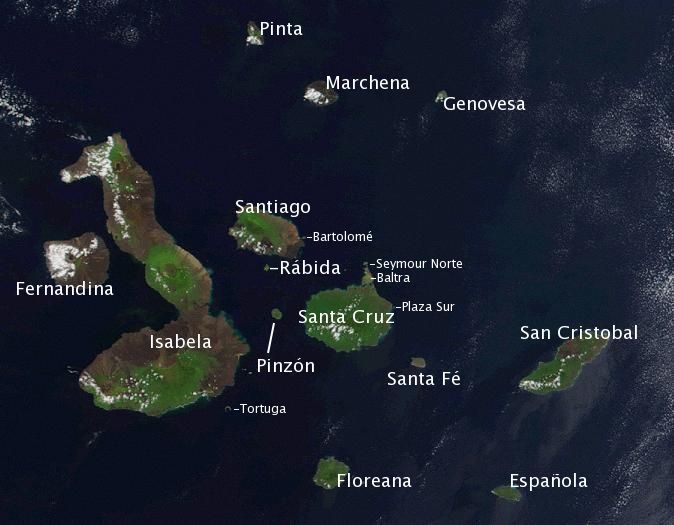A major attraction in the Galapagos islands is the myriad of under water creatures and adventures just waiting to be seen and experienced in many diving and snorkeling sites. This is why we spent 2 days from our time there in diving tours.
We booked our first diving day on the day we arrived to the islands in the main town of Isla Santa Cruz, Puerto Ayora. We both wanted to dive at a place called Gordon Rocks because it is the most likely place to see hammerhead sharks. We decided to go with the most recommended (and most expensive) diving company because Gordon Rocks is considered to be a rather difficult diving site and that dive contains skills we lack such as dealing with strong currents, drift and diving from a boat into rough sea.

So the next day, early in the morning, we were on a small boat with 4 other divers, 2 guides and the boat´s captain sailing at full speed to Gordon Rocks. (in the eastern side of Isla Santa Cruz in the following satellite photo)

The diving site is constructed of a series of rocks arranged at a semi-circle. The rocks at the 2 edges of the semi-circles are bigger then the others and they are the only ones that emerge to the surface. All the other rocks (about 5-6) are cone shaped and have gaps of about 10-20 meters between them. An almost steady current is entering the semi circle and speeding between the pinnacles to a very strong and dangerous current. The dive plan is to stay at around 25-30 meters below the surface and go to the floor between the pinnacles (arr. 30-35 m) where the current is weaker.

The first dive started wonderfully, immediately after descending to 25m we saw 2 hammerheads swimming about 3 m below us. Unfortunately, those were the only ones I saw that day (and ever). From that moment on the dive was more about the technical skills. There were a few tropical fish, rays and turtles but most of my attention was in fighting the currents, clinging to the rocks when the current was too strong (we had special gloves for that) and quickly crossing the gaps.



When it was time (air, to be exact) to surface I had what I believe is the most frightening diving experience I ever had. We were rising quite close to the rocks where the waves are making plenty of tiny air bubbles in the water when they brake on the rocks. What we experienced when we were attempting to do a safety stop is a sudden change in the water color from clear blue to blinding white. We tried to stay together but couldn't. I tried to look at the watch or the meters but couldn't read them from distances bigger then 10 cm. Suddenly, I felt the water turning me and rolling me. I decided to surface immediately and not complete the safety stop (it´s only for safety..). Guarding my face from the rocks and my head from the boat I surfaced slowly. That is, I think I did because was completely disoriented. When I reached the surface I saw Karin about 20 m from me.

The second dive there was fine but I saw no more sharks.

Our second diving day next to a small island called Isla Tortuga next to Isla Isabela.

The weather was cloudy, the visibility in the water was close to nothing and except one sea turtle, that I got to get very close to, we didn't see anything worth mentioning. In the diving area, on the other hand, it wasn't boring.
The only diving center in Isla Isabela is run by 2 guys who can't speak English. They declare themselves fishermen / dive masters and indeed we saw that our guide has a PADI dive master licence. However, he doesn't use a watch, a diving computer or any other device to tell him if the dive is safe or not. We went diving with him and it was only him and us. No other divers.
The first dive with him was full of annoyances. As we reached our target depth (with this guy there was no slow decent. He was swimming down to 20-30m as fast as possible .. straight into the abyss) my mask tore and I had to surface to get a new one. By the time I returned we had a very short diving time until Karin's air ran out and it was my turn to wait at the bottom while she surfaced.
The second dive with him was delightful. I didn't see anything but got to master the diving technique of drifting and dealing with currents. It's really nice to see the fish swaying with the drift and to know when to sway with them and when to grasp the rocks.
No comments:
Post a Comment